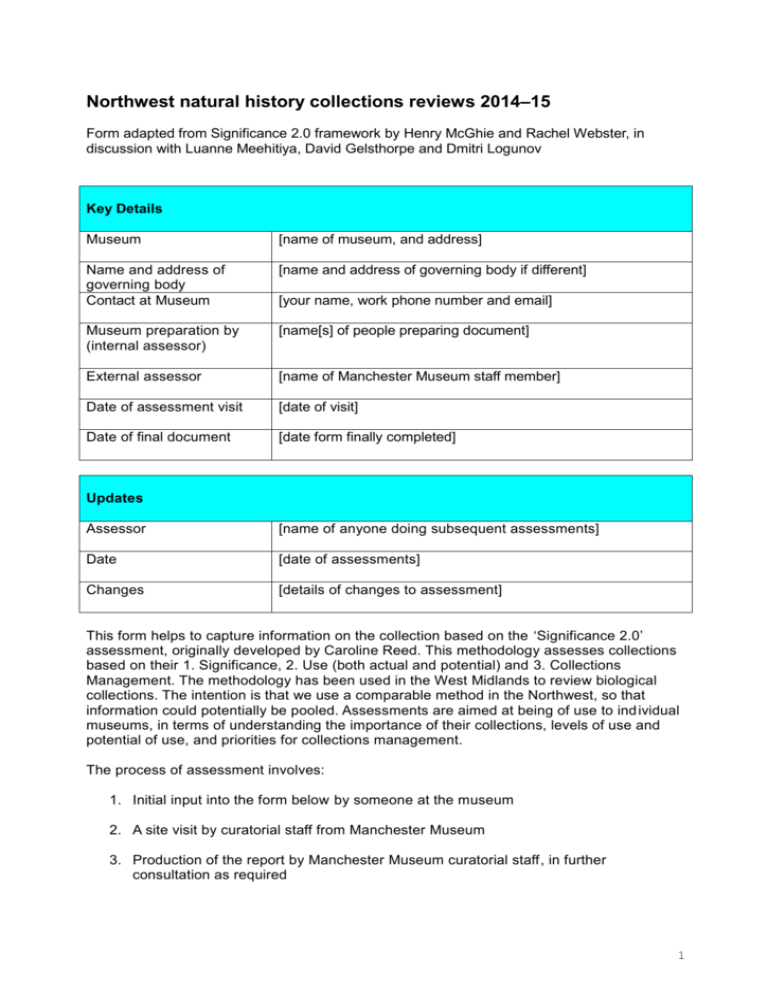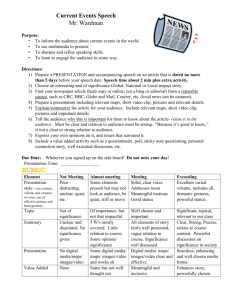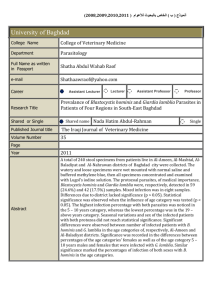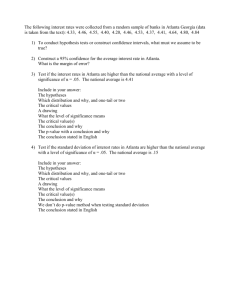Northwest natural history collections review form TEMPLATE
advertisement

Northwest natural history collections reviews 2014–15 Form adapted from Significance 2.0 framework by Henry McGhie and Rachel Webster, in discussion with Luanne Meehitiya, David Gelsthorpe and Dmitri Logunov Key Details Museum [name of museum, and address] Name and address of governing body Contact at Museum [name and address of governing body if different] Museum preparation by (internal assessor) [name[s] of people preparing document] External assessor [name of Manchester Museum staff member] Date of assessment visit [date of visit] Date of final document [date form finally completed] [your name, work phone number and email] Updates Assessor [name of anyone doing subsequent assessments] Date [date of assessments] Changes [details of changes to assessment] This form helps to capture information on the collection based on the ‘Significance 2.0’ assessment, originally developed by Caroline Reed. This methodology assesses collections based on their 1. Significance, 2. Use (both actual and potential) and 3. Collections Management. The methodology has been used in the West Midlands to review biological collections. The intention is that we use a comparable method in the Northwest, so that information could potentially be pooled. Assessments are aimed at being of use to ind ividual museums, in terms of understanding the importance of their collections, levels of use and potential of use, and priorities for collections management. The process of assessment involves: 1. Initial input into the form below by someone at the museum 2. A site visit by curatorial staff from Manchester Museum 3. Production of the report by Manchester Museum curatorial staff, in further consultation as required 1 Summary Number of natural history specimens % of natural history collection adequately stored % of natural history collection with data % of natural history collection documented on computer (to specimen/bulk level) No. of visitors to stored collections per year No. of visitors to museum per year State of building- external State of building- internal 1994 [From Skeletons in Cupboard] [From Skeletons in Cupboard] [From Skeletons in Cupboard] [From Skeletons in Cupboard] [From Skeletons in Cupboard] [From Skeletons in Cupboard] [From Skeletons in Cupboard] [From Skeletons in Cupboard] the 2014/15 [from below] the [from below] the [from below] the [from below] the [from below] the Please complete the V Good/ Good/ Acceptable/ Poor/ V Poor V Good/ Good/ Acceptable/ Poor/ V Poor the Comments from ‘Skeletons in the Cupboard’ (1994/98): [From Skeletons in the Cupboard] Significant developments in governance since 1994… Significant developments to building (stores/galleries) since 1994 (eg. lottery, Wolfson, Esme Fairbairn funded projects etc.)… Significant externally funded projects to enhance state of collection (collections care, acquisition) or its interpretation (eg. digitization, documentation, conservation projects), and sources of funding since 1994… Significant changes to general state of building since 1994 (deterioration, improvement etc.) when the museum was described as xxxxxx externally and xxxxxxxx internally…[xxxxxxxxx from Skeletons in the Cupboard] Significant developments to collection since 1994… Plans relating to natural history collection, use and display for the next 10 years… Significance Usage Storage/collection 2 ‘Significance 2.0’ rating Organisational or site specific/ Community of Group/ Locally specific/ Regional or Cross-regional/ National or International Rating of collection importance 1994: V Low/ Low/ Moderate/ V High/ Unknown management V Poor/ Poor/ Fair/ Good/ Excellent Overall ‘Significance 2.0’ rating 2014/15: 3 Significance: Provenance Question Answer Who created the core collection? When, where and why was the collection made? [a brief narrative of the history of the collection and if it came from any previous museums. This section doesn’t require any detail, it is at an institutional level] When / for how long has the collection been used? [has use been continuous since your museum opened?] Were parts of the collection acquired subsequently? How/when/why/from whom? [this is at a high level, not individual acquisitions. Were large collections acquired at different times? This is just to give a general sense of major developments] Were parts of the collection disposed of subsequently? How/when/why/to whom? [in terms of significant amounts of material: whole sections of a (natural history) collection etc. Disposal includes transfer, exchange and destruction] Outline sub-collections [include only natural history collections, ie. preserved animals, plants, rocks, fossils. This section only needs a very brief narrative of how the collection is organized as a fuller breakdown is required below] Does the museum include other types of collection Live animals Archaeology Anthropology Other (please specify) Are any published or online catalogues of the collection, or descriptions of the collection’s contents? What archival information is held? What is the legal ownership of the collection? Industrial collections Social history Art and crafts Yes No [ie. can people find out about what is in the collection before a visit] [only in relation to your natural history collection] -accession books -collectors’ records and notebooks -notebooks -institutional archives -images/photographs [who owns the collection] Is the museum Accredited? Yes Are there significant long term loans in or out of the collection? Have any specimens been acquired in the last 10 years. If so, approximately how many, how, and of what? No Yes No [this is included as loans may influence the significance and impact of the collection] Yes No How?: Field collecting Donation Transfer from other museum Purchase of specimens Other methods 4 Have any specimens been disposed of in the last 10 years? If so, approximately how many, how, why, and of what? [this is intended to give a sense of the scale and speed of acquisition.] [disposal includes transfer, exchange and destruction] Significance: Description of the collection Taxidermy mounts Number in Skeletons in the Cupboard [from ‘Skeletons’] Birds Mammal Other mounts Study skins Birds Mammals Others Bones and skeletons Eggs Insects (dried) Molluscs (dried) Spiders, crabs (dried) Corals and sponges (dried) Other invertebrates Spirit jars (all types of specimen) Microscope slides Herbarium sheets Other plant specimens including fungi (boxes of galls, wood etc) Biological models Animals (including single-celled) Plants Other Rocks Minerals Fossils Other geological (sections, drill-cores etc) Archive material Lantern slides Current number (2014/15) Is this number: [a Victorian case of 50 hummingbirds= 1] accurate/estimate accurate/estimate accurate/estimate [from ‘Skeletons’] [from ‘Skeletons’] [from ‘Skeletons’] [from ‘Skeletons’] [from ‘Skeletons’] [from ‘Skeletons’] Eggs (individuals)= Separate layings/clutches= [individual shells] accurate/estimate accurate/estimate accurate/estimate accurate/estimate accurate/estimate accurate/estimate accurate/estimate accurate/estimate accurate/estimate [from ‘Skeletons’] accurate/estimate accurate/estimate [from ‘Skeletons’] [from ‘Skeletons’] [from ‘Skeletons’] accurate/estimate accurate/estimate accurate/estimate [from ‘Skeletons’] accurate/estimate [from ‘Skeletons’] [from ‘Skeletons’] [from ‘Skeletons’] [from ‘Skeletons’] [from ‘Skeletons’] accurate/estimate accurate/estimate accurate/estimate accurate/estimate accurate/estimate accurate/estimate accurate/estimate accurate/estimate 5 TOTAL OF ABOVE [from ‘Skeletons’] Is there a separate Handling/Education collection, and if so please give rough details [Please give brief narrative to explain differences in numbers between time of Skeletons in the Cupboard and the present situation. Are differences a result of more accurate counting, or of collections acquisition/disposal, and if so, of what?] Significance: Rarity/uniqueness- do on a subcollection basis if you want Question Description Does the collection contain specimens that were the basis of new species (type specimens) or specimens referred to or illustrated in books/scientific papers? If so, can you give details or publications? Types: Yes No Maybe Illustrated/figured: Yes No Maybe Publications (or estimated no. of publications if a lot)…. Does it contain recently extinct or endangered species, if so give a description? What are the strengths of the collection? Is the collection unusual in some way? What proportion of the collection has locality data? Yes No Maybe [break this down into subcollections if you want] eg. -geographical -collectors -social history -history of science and discovery timespan [break this down into subcollections if you want] (90% in Skeletons in the Cupboard) Narrative- summary of significance based on Significance 2.0 [to be completed following site visit] 6 Significance: Visual and sensory impact for exhibition/presentation/source of inspiration (including web) Question Description What parts of the collection have a strong potential impact for exhibition/presentation/storytelling (including web)? What are the potential "star specimens" or groups of specimens for exhibitions/presentation/storytelling? Narrative- summary of significance based on Significance 2.0 [to be completed following site visit] Significance: Condition Question Is the collection in good condition for its type: is it usable? Description Yes No Mixed Narrative- summary of significance based on Significance 2.0 [to be completed following site visit] Significance: Historical meaning Question Description Who are the major collectors or donors? Is the collection associated with a particular person or family group? Is the collection associated with a particular place? What is the mix of local, regional and national material? Is it associated with particular activities? Is there a collection method that dominates the collection? (eg. big game hunting, field naturalism, research collection) 7 Narrative- summary of significance based on Significance 2.0 [to be completed following site visit] Significance: Potential for use (exploitability) Question Description Does/could the collection be used for scientific research? (=does it contain specimens with good quality locality data) Yes No Maybe Comments….. [please give narrative] Does/could the collection be used for arts and humanities research? (languages, history, social history, art etc) Does/could it enrich the understanding of other material in your collection? Does/could it support National Curriculum based or other learning activities (including adult)? Does/could it be used to reach new audiences? Could it support reminiscence work or other arts and health initiatives? Does/could it inspire creativity or support income generation, business or product development (either for the museum or external users)? Does/could it support profile raising and tourism? Has it ever/ could it be loaned for display/research by other heritage organisation(s)? Yes No Comments….. [please give narrative] Maybe Yes No Maybe Comments….. [please give narrative] Yes No Comments….. [please give narrative] Maybe Yes No Comments….. [please give narrative] Maybe Yes No Comments….. [please give narrative] Maybe Yes No Comments….. [please give narrative] Maybe Yes No Comments….. [please give narrative] Maybe Yes No Comments….. [please give narrative] Maybe Narrative- summary of significance based on Significance 2.0 [to be completed following site visit] 8 Significance summary Significance summary [to be completed following site visit] ‘Skeletons in the Cupboard’ evaluation [to be completed following site visit] Summary of significance [to be completed following site visit] 9 Usage: Marketing and communications Is the collection: Comments (inc. frequency, examples and increases or decreases in use) Strongly identified in the public’s mind with the museum (eg. feature in marketing, imagery)? Yes/No Used in social media? Yes/No Used for marketing? Yes/No Of media interest? Yes/No Is use of the collection for marketing and external communications Summary of popular appeal Increasing Comments….. Stable Decreasing Very high High Moderate Low Unknown Narrative- summary of significance based on Significance 2.0 [to be completed following site visit] Usage: Supports formal (ie. schools, colleges and universities) learning Is the collection used for: Comments (inc. frequency, examples and increases or decreases in use) Used in visits to the museum by school groups? Used outside the museum by school groups? Yes/No Higher education learning (undergrad, postgrad student projects, lectures, part of coursework)? Yes/No Interdisciplinary learning/ for non-science subjects e.g. for art? Yes/No Is use of the collection for formal learning Yes/No [includes specimens in any Education/handling collection] Yes/No [comments, and approx. no. of students per year] Increasing Comments….. Stable Decreasing 10 Narrative- summary of significance based on Significance 2.0 [to be completed following site visit] Usage: Supports informal/lifelong learning Is the collection used for: Comments (inc. frequency, examples and increases or decreases in use) Interdisciplinary learning e.g. for art? Yes/No Public events with nonschool groups/visitors in the museum? Yes/No Public events away from the museum (outreach, not schools outreach)? Yes/No Volunteers working with the collection in the museum? Yes/No Is use of the collection for lifelong learning Increasing Comments….. Stable Decreasing Narrative- summary of significance based on Significance 2.0 [to be completed following site visit] Usage: Research and enquiries In the last 5 years, has the collection been: Used for enquiries? Roughly how many a year Used for academic research?- how many projects, roughly how many specimens each year Yes/no No. and comments….. Yes/no Approx. no of separate projects per year (1, 10, 100, 1000, more) ………….. (academic research= research aimed at publication) Approx no. of specimens per year (1, 10, 100, 1000, more)…………... Used for self-directed (‘amateur’) research (ie. not part of school or university coursework)? Yes/no 11 Cited in publications? Yes/no Used for research loans? Yes/no Is use of the collection for supporting research and answering enquiries Increasing Comments….. Stable Decreasing Narrative- summary of significance based on Significance 2.0 [to be completed following site visit] Usage: Current public access Published, for example in catalogues? Yes/no Comments (inc. frequency, examples and increases or decreases in access) Searchable online? Described online? Is the natural history collection on permanent display? If so, what proportion of the natural history collection is on display? Yes/no Yes/no Yes/no Comments… Comments… % of collection on display…… Is there highly visual/attractive material in store? Yes/no Comments… Physically accessible in store e.g. for wheelchair users? Yes/no Comments… Able to be accessed in store, and by what process? Yes/no [eg. by booking appointment] Does layout of store and documentation facilitate use? Yes/no [can objects be easily found in store] Are facilities available for researchers to work e.g. work space with microscope, visitor space/desk? Yes/no Comments… Is public access to the collection (ie. how much of the collection is available to the public for use in all kinds of programmes) Comments… Increasing Comments….. Stable Decreasing 12 Narrative- summary of significance based on Significance 2.0 [to be completed following site visit] Usage summary The use of the collection overall (both stored and on display) is High Moderate Comments………… Summary description, including the most significant use of the collection [to follow site visit] Low Comparison of actual and potential use, and what barriers would need to be overcome? 13 Collections management Security and emergency planning Stores/storage units/collections cabinets locked when not in use? Yes/No Visitor access to stores Yes/No controlled/limited/restricted? Intruder alarm Yes/No Comments… Smoke alarm Yes/No Comments… All alarms linked out of hours to external service Yes/No Comments… Threat from external / internal water penetration minimised Appropriate fire extinguishers Yes/No Comments… Yes/No Comments… Regular security checks of buildings and collections Yes/No Comments… Emergency plan and location plan in place Yes/No Comments… Are natural science hazards noted on emergency plan? Yes/No Comments… Emergency equipment kit accessible / clearly marked Yes/No Comments… Staff trained in emergency recovery Yes/No Comments… Location plan available with ‘star’ items for emergency recovery clearly marked. Are natural science star specimens well identified? Contract / partnership arrangements in place for emergency recovery / temporary storage Yes/No Comments… Yes/No Comments… Comments… General description of security: Narrative- summary of significance based on Significance 2.0 [to be completed following site visit] Storage area Dedicated room for stored museum collections Dedicated area for natural science collections, where sensible Yes/No Comments… Yes/No Comments… Adequate racking Purpose built, inert racking Yes/No Yes/No Comments… Comments… Health and safety compliant Yes/No Comments… No collections on floor level Units numbered & labelled Is the collection store (not the specimens) adequately spaced Yes/No Yes/No >75% of store adequate 25-75% of store adequate <25% of store adequate Comments… Comments… Comments… Individual objects safely retrievable Adequate trolleys etc for safe movement within & between museum spaces Handling/inspection areas No signs of damp or other building issues General description of storage methods: Yes/No Comments… Yes/No Comments… Yes/No Yes/No Comments… Comments… Narrative- summary of significance based on Significance 2.0 [to be completed following site visit] Exhibitions/display environment Showcases adequate in terms of security and robustness Yes/No Comments… Showcases made from inert materials Showcases dust proof Yes/No Comments… Yes/No Comments… Objects on display well supported and protected Appropriate measures taken to minimise light damage Conservation grade display mounting materials Are there historic displays where modernisation is not desirable? Give outline of what natural sciences exhibitions you have, and significant developments over the last 15 years (since ‘Skeletons’ was produced) Yes/No Comments… Yes/No Comments… Yes/No Comments… Yes/No Comments… Narrative- summary of significance based on Significance 2.0 [to be completed following site visit] Packing of objects and specimens % of natural history collection adequately stored (number will go in overview table near start of document) Proportion of objects adequately protected from dust and pollutants Most (>75%) Some (25-75%) Few (<25%) Comments… Most (>75%) Some (25-75%) Few (<25%) Comments… Protection from pollutants achieved by: Store Cabinet Boxing Comments… Objects adequately stored for accessibility (e.g. in single layer within boxes where appropriate) Most (>75%) Some (25-75%) Few (<25%) Comments… All new packing materials used are conservation grade where required Comments… All packing materials present are conservation grade where required Comments… General description of packing/storage of specimens: Narrative- summary of significance based on Significance 2.0 [to be completed following site visit] Environment Temperature / RH continually monitored & analysed weekly Yes/No Comments… Temperature and RH controlled & stable at optimum level for stored material Yes/No Comments… Environmental monitoring equipment calibrated biannually Yes/No Comments… Adequate ventilation, esp. for natural history collections Yes/No Comments… Light & UV monitored & controlled Yes/No Comments… Regular, frequent cleaning cycle Yes/No Comments… Integrated pest management system in operation Yes/No Comments… Staff confident at ID of pests and other sources of damage to specimens Yes/No Comments… Known pest issues: Yes/No Comments… General description of environment Narrative- summary of significance based on Significance 2.0 [to be completed following site visit] Condition Question Yes/No Description Regular inspection checks carried out Yes/No Material stable (in conservation sense- not deteriorating- it can be stable but dusty) Most (>75%) Some (25-75%) Few (<25%) Material dirty/dusty/needing repair (ie. does it need preparation before main potential use) Most (>75%) Some (25-75%) Few (<25%) Any condition concerns Narrative- summary of significance based on Significance 2.0 [to be completed following site visit] Documentation Question Yes/No What proportion of specimens are labelled with their accession/ID number? Most (>75%) Some (25-75%) Few (<25%) What proportion of specimens are numbered on database Most (>75%) Some (25-75%) Few (<25%) What proportion of specimens have basic catalogue, or are covered by inventory/bulk records? Most (>75%) Some (25-75%) Few (<25%) What proportion of specimens have full catalogue records on a computer database? Most (>75%) Some (25-75%) Few (<25%) What proportion of specimens have full catalogue records on any other type of system (eg. card index, accession book, collection paper catalogue)? Most (>75%) Some (25-75%) Few (<25%) What kind of system?..... Catalogue information available to external researchers & general public? If so, on site and/or online Yes/No Supporting paper-based Yes/No Description documentation easily accessible Documentation procedural manual up to date Yes/No Location of specimens up to date on documentation system Most (>75%) Some (25-75%) Few (<25%) General description of documentation Narrative- summary of significance based on Significance 2.0 [to be completed following site visit] Specialist collections needs Question Description Human remains, especially those less than 100 years old [these need to be certified under the Human Tissues Act] CITES [to control and prevent trade in endangered species- relates to charging for exhibitions etc] [risks of chemical contaminants, biological hazards etc] Health and safety hazards relating to collections and their treatments Number of permanent curators working with collection Number of natural history trained curators working directly with collection Number of curatorial assistants/technicians working directly with collection Number of conservators working directly with collection Number of volunteers working on natural sciences collections. Number with specialist knowledge. Aware of sources of advice for biological collections? Is there any specialist knowledge the collection could benefit from? FTE include all curators who might work with collection, so not just natural sciences curators] FTE FTE FTE Any risks to the collections not previously noted Collection summary The significance of the collection is: The usage of the collection is: The level of collections management is: Overall summary Recommendations Action points for reviewer Action points for reviewee






